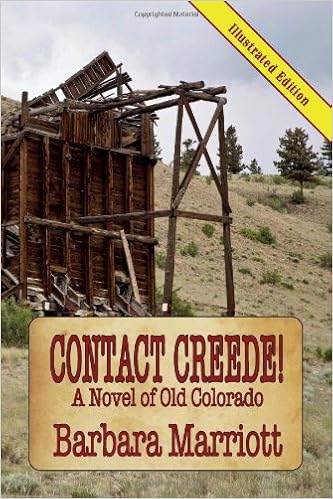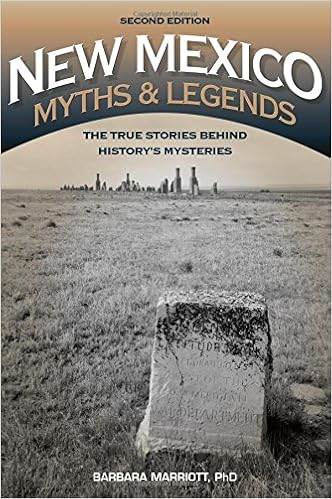I know this incredible author from my days at Fireship Press. From
University Professor, to Management Consultant and Trainer, to Creative
Advertising Director, Barbara Marriott’s professional fields have allowed her to
observe life. However, it is her Ph.D. in cultural anthropology from
the University of Florida that gives her the tools to get to the very
core of her subject, and to satisfy her unquenchable need to know.
Barbara Marriott was elected to Who’s Who in American Woman, and has the
distinction of flying with the Navy Acrobatic team, the Blue Angels.
MJN: You were
born in New Jersey, yet most of your novels are set in Colorado or New
Mexico. I am not surprised by your fascination with the West. Now those
states are developed and suburbanized, for the most part, but there are some
pockets of wilderness. Clearly, you've traveled a lot more than I
did. Would you say that there are still parts of the US that look the
same way that they did 100 years ago?
BM: There are few areas that have not been touched by the demands of
people. Developments and modernization
are found even in the most remote and rural areas of the west. There are a few pockets of make-believe like
Old Tucson and Tombstone that try to cater to the demands of people for the old
west. There are always the old ghost
towns, usually nothing more than a few tumble down buildings and a dirt
road. Ruby is one of the better ones to
see, hard to get to but worth it. The best feel for the old west is the
roadside. You can travel for miles along
the back roads and nothing has changed in100 years. One of the nicest old towns
is Creede CO. They kept their old time
look and instead of dressing it up with cheap souvenir shops aka Bisbee, they
took care of their old buildings and are using them to live in…what an original
concept. But in all visits the most important companion is imagination.
MJN: You state
in your biography that the location and the events are secondary, and that your
focus is on the human experience. Would you say that the political and
geographic settings are just the frame for the painting or the actual
canvas?
BM: It is a
strange association, rather like the nature/nurture debate. Do the culture aspects such as social, political,
economical, religion, etc., define human behaviors, or do human behaviors
define the culture? I first look at who
did what and why, and the why usually is driven or explained by the structures
of the culture. Culture is a frame, but it is also the canvas upon which play
human lives.
MJN: You mention your fascination with outlaws, pioneers and ... liberated women. Many of your works are set in late 19th century, which was a time when the feminist movement was gaining momentum. I imagine, that being a liberated woman in 1890 meant something different than it does nowadays. Of course, there are all those superficial expressions of girls power, from refusal to wear a corset to refusal to shave legs. What about a deeper sense of female empowerment and how it has evolved over the past century?
BM: OK now you really want a dissertation. Women have always had it within them to do
whatever they wanted to do. In the old
west there were female shop owners, doctors, lawyers, explorers, soldiers,
scientist and many more. Historically it meant giving up the traditional roles,
being highly determined, and in some cases devious. It wasn’t until high tech got involved that
women were “liberated.” Vacuum cleaners,
dishwashers and washing machines diminished their workload and gave them free
time to pursue their interests. War also
helped. Women entered the ranks of
workers during both WWI and WWII, some never left. Hard labor was made lighter by helpful
inventions concerning equipment; the strength factor was eliminated, or at
least diminished. The rest was just a
matter of working the mind of men around to the thought of equality. However, what we lost what was in the mind of
most men for generations. Women were
special and could do things (besides child birth) that men could not do. I think men knew all along in history that
women could do what they did…if they wanted to.
MJN: Let's talk about your relationship with Fireship press. Like me, you are one of the senior members, for lack of better word, who were brought on board under Tom Grundner (God rest his soul!) I'm pleased to see that the press is still in existence and continues to attract outstanding authors. What do you think sets Fireship's selection apart?
BM: Tom was one
of the few people I know who really cared about his authors. He was brilliant, far beyond his time
creatively, and I sometimes wonder what he would be doing if he was still
here. He saw the publishing business
going beyond the printed word with what are now e-books, talking tapes, and
books on flash drives. I think today
Fireship is still willing to give the beginning author a chance. I sent two aspiring authors to Fireship years
ago, both got published and their careers were launched.
MJN: Tell me about the awards you've won. Undoubtedly, they increase your credibility in the world of serious historical writers. But do they actually increase an author's marketability? Do you think most readers care about the author's merit credentials?
BM: Every one of
my books, except two, (I have 12 books out) has won some sort of award. Of the two, one was never entered in a
literary contest, and the other was recently published. I am deeply honored and pleased by the
recognition, however it does not translate to the bottom line. Readers do not care about awards. What is far, far more important is
exposure. It is very hard to come
by. Amazon.com lists books by the number
of reviews, and now had clamped down on reviews from friends and family. Getting the word out is expensive and hard to
do. Most publishers do not spend the
money, nor do they have the time to publize their authors’ works.




No comments:
Post a Comment